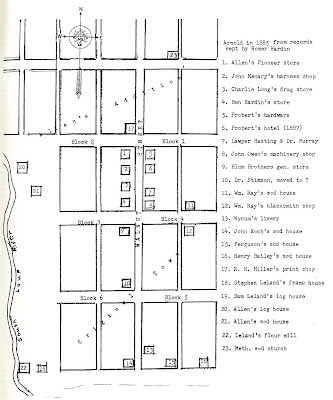Sunday Stories: Arnold
Excerpted from: One Hundred Years on the South Loup
The little store could no longer provide for the needs of
the settlers, it was time for a town. There was town-building fever in the
country in the early 1880s – Broken Bow in ’82 – Callaway and Gandy in ’85 –
Merna and Anselmo in ’86 – but unlike her sister villages, platted by townsite
companies, Arnold was established by one man, Richard Allen. It was September
of 1883 when Allen called County Surveyor Bishop over from Broken Bow to plat
six square blocks of his homestead for a townsite to be called “Arnold” after
the post office by that name. His main street he called “Walnut” for the trees
at his home.
Probably there was not much done on the new site that fall.
Reports to the County paper told of fifteen inches of snow on the ground by
late October and bitterly cold weather. In a November Storm, Oscar Howe was
caught between Arnold and North Platte and had to leave his team and wagon and
walk home. When he returned, he found the horses dead – frozen to death. The
Kilmers, caught in the same storm while on a trip to the Dismal after cedars,
lost four of their horses. A party in camp nine miles north lost eleven horses.
After a town is laid out, residents, and at least a few
businesses, must be attracted. One way to do this was to give away lots and
this Allen did. He offered free lots to those who would come, settle, and go
into business. A residence lot would be included. But he was choosy, “Only
good, honest “square-toed” men of family are solicited,” he wrote.
Another way was to have the new town boosted in an area
paper. It is known Allen made several trips to the office of the County Republican in the spring and summer of ’84, and from time to time this paper
published such items as: “Arnold is booming! 180 acres of prairie are broken
out, the surrounding hills and valleys are dotted with houses, there are
prairie chickens by the thousands and deer abound!”
Other articles praising the country appeared – J. W. Brewer,
up in Powell canyon, raised eight-pound turnips on ground from which the sod
had been stripped for a house – deer were so plentiful Jeremiah Howe had killed
two with one shot from the doorway of his house – one settler had already sold
a claim for $500 – the railroad was coming, maybe before the year was out –
Arnold was almost certain to be the county seat of a new county that would be
formed when Custer was divided. (Division had first been voted on in 1879, just
two years after organization. Other elections on the matter were held in ’86,
’87, ’88, ’90, ’92, ’97, 1909 and 1910. The last division convention was held
in 1916, but it did not come to a vote. With the advent of cars and passable
roads, agitation ceased and residents became resigned to their giant county.)
Petitions were being circulated for a good road between
Arnold and Broken Bow, suitable for teams pulling a loaded wagon. Travelers on
this road were assured of food and lodging at the home of Samuel High, the
half-way point. Mr. High promised plenty of water for teams from the two
cisterns he would keep filled with lagoon water.
Spiritual needs of new townspeople would be met by Elder
Correll of the Christian faith, Nathan English of the Methodists and Charles
Kilmer of the Winebrenerians.
And they came. That spring of 1884, wagons coming up the
trail along the Loup carried not only land seekers but those with a vocation –
blacksmith, printer, butcher, carpenter, lawyer, merchant, harness maker,
doctor.
Building began almost as soon as the snow had melted enough
to find the stakes in the buffalo grass.
First to go up was Richard Allen’s Pioneer Store on a choice
corner (Arnold Café site), and he moved the supplies and the post office from
the soddy into it. He hired Milldale homesteaders Abner Brown and Josiah
Wilcher, to haul the lumber and do the carpenter work. As a clerk in his store,
Allen hired Swain Finch’s young nephew, John Finch, newly married to May Kelley
from Cozad, where John had been postmaster and operator of a general store for
two years.





00B8E4D497
ReplyDeletehacker bul
hacker bul
tütün dünyası
-
-